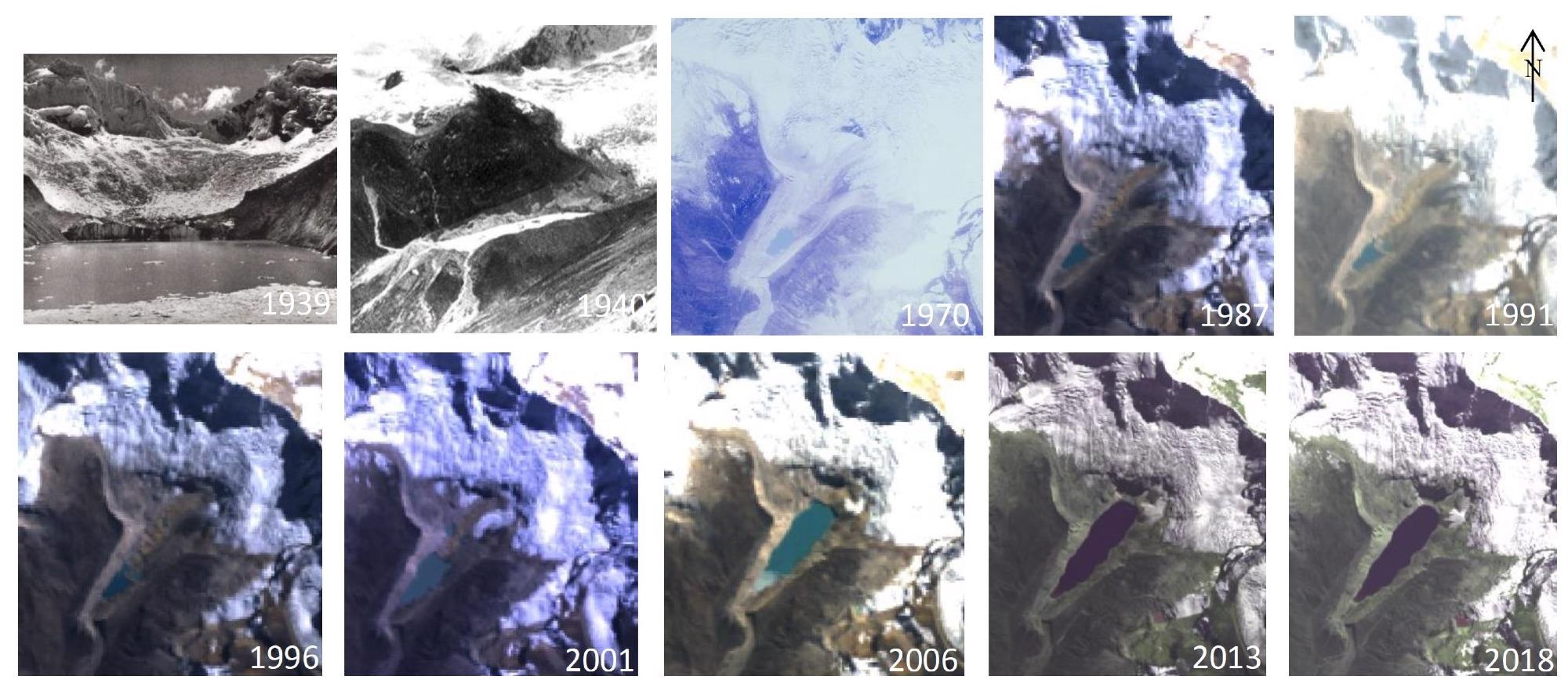Feb 5 2021
The warming of Earth has caused glaciers to retreat, leading to changes in mountain water systems across the globe.
 Historical photographs (first three panels) and satellite images show how Lake Palcacocha has grown as the glacier has receded. The lake is now about 34 times its volume in 1970. Image Credit: Stuart-Smith et al./Nature Geoscience.
Historical photographs (first three panels) and satellite images show how Lake Palcacocha has grown as the glacier has receded. The lake is now about 34 times its volume in 1970. Image Credit: Stuart-Smith et al./Nature Geoscience.
Researchers from the University of Oxford and the University of Washington (UW) have, for the first time, directly linked human-induced climate change to the threat of flooding from a glacial lake—one of the worst flood risks in the whole world.
The study investigated the case of Lake Palcacocha in the Peruvian Andes, which could lead to flooding with destructive impacts for 120,000 residents in the Huaraz city.
The study was published in the Nature Geoscience journal on February 4th, 2020, and offers new proof for an ongoing legal case that revolves around the relationship between greenhouse gas emissions and specific effects of climate change.
The scientific challenge was to provide the clearest and cleanest assessment of the physical linkages between climate change and the changing flood hazard.
Gerard Roe, Study Co-Author and Professor of Earth and Space Sciences, University of Washington
In 2016, Roe and his team devised a technique to find out if a single glacier’s retreat can be connected to human-induced climate change. The retreat of mountain glaciers includes many impacts, such as the formation of basins in the space left behind by the retreating glacier.
Precipitation and meltwater get accumulated in these basins and develop glacial lakes. The latest study has demonstrated a quick global increase in the size and number of high elevation glacial lakes.
We believe our study is the first to assess the full set of linkages between anthropogenic climate change and the changing glacial lake outburst flood hazard. The methods used in our study can certainly be applied to other glacial lakes around the world.
Gerard Roe, Study Co-Author and Professor of Earth and Space Sciences, University of Washington
First, the researchers estimated the role played by human emissions in the noted increase in temperature right from the beginning of the industrial era throughout Palcaraju Glacier. It shows that human activity accounts for 95% of the observed 1°C (1.8°F) warming in this area since 1880.
Then, the team employed the UW-developed method to evaluate the link between these warming temperatures and the noted long-term retreat of the glacier that has resulted in the widening of Lake Palcacocha.
The study findings indicate that it is almost certain, with a probability higher than 99%, that human-induced climate change has resulted in the retreat of Palcaraju Glacier.
Then, study lead author Rupert Stuart-Smith, a doctoral student at Oxford, made use of two techniques to evaluate the threat of glacial lake outburst flooding, wherein an avalanche, rockfall, or landslide triggers a tsunami wave that exceeds the banks of the lake, to show how the development of Lake Palcacocha impacts the flood risk experienced by the city of Huaraz.
“We found that human influence on climate—through greenhouse-gas emissions—is responsible for virtually all of the warming that has been observed in the region,” stated Stuart-Smith, who spent the summer of 2019 at the UW. “The study shows that warming has caused the retreat of the Palcaraju Glacier, which in turn has greatly increased the flood risk.”
The study offers new proof for an ongoing legal case in the German courts where Saúl Luciano Lliuya, a farmer from Huaraz, has sued RWE, Germany’s leading electricity producer, for its role in contributing to global warming. The case seeks reimbursement for present and future flood-risk reduction efforts.
Crucially, our findings establish a direct link between emissions and the need to implement protective measures now, as well as any damages caused by flooding in the future.
Rupert Stuart-Smith, Doctoral Student, University of Oxford
Huaraz has been threatened by climate change even before. An outburst flood from Lake Palcacocha in 1941, caused by an ice and rock slide, killed nearly 1,800 people. The study found that this flood was also influenced by human-induced climate change, which makes it one of the earliest recognized fatal impacts of climate change.
The recent growth of the lake strains decades of engineering attempts from the 1970s to manage the lake’s water.
“Around the world, the retreat of mountain glaciers is one of the clearest indicators of climate change,” stated Roe. “Outburst floods threaten communities in many mountainous regions, but this risk is particularly severe in Huaraz, as well as elsewhere in the Andes and in countries like Nepal and Bhutan, where vulnerable populations live in the path of the potential floodwaters.”
Myles Allen and Sihan Li from the University of Oxford are the other co-authors of the study. The research was financially supported by the U.K. Natural Environment Research Council, the U.S. National Science Foundation and a grant from the University of Oxford.
Journal Reference:
Stuart-Smith, R. F., et al. (2021) Increased outburst flood hazard from Lake Palcacocha due to human-induced glacier retreat. Nature Geoscience. doi.org/10.1038/s41561-021-00686-4.